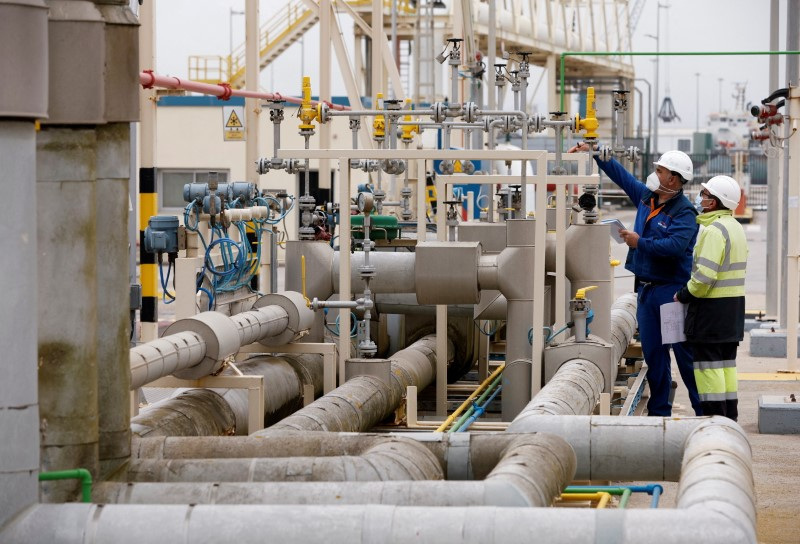EU wants new transaction based LNG benchmark in bid to calm prices
2022.09.29 15:02

© Reuters. FILE PHOTO: People work at Enagas liquefied natural gas (LNG) terminal at Zona Franca in Barcelona, Spain, March 29, 2022. REUTERS/Albert Gea/File Photo
By Bozorgmehr Sharafedin, Kate Abnett and Marwa Rashad
LONDON (Reuters) – The European Union wants a new transaction-based benchmark for liquefied (LNG) as it says the fall in Russian pipeline gas flows and record high LNG imports have created imbalances in the current pricing mechanism.
The 27 EU member countries are negotiating proposals made last week to control soaring energy prices and rein in costs for consumers but Brussels is already exploring additional measures.
In a paper shared with member states on Wednesday night and published on Thursday, the EU Commission said an alternative LNG price benchmark – which market participants could use voluntarily – should be based on verifiable price assessments for LNG cargo deliveries, to ensure it reflected real-world prices for the fuel.
“The complementary benchmark would limit the current negative effect on price formation due to [pipeline] infrastructure bottlenecks and is thus expected to bring prices closer to the world market level,” it said.
Buyers of LNG usually price off benchmarks such as the Henry Hub for natural gas prices in the United States or the Japan Korea Marker (JKM) in Asia, with a small spread added to account for the costs of regasification and transferring the gas to the grid.
In Europe, the standard benchmarks are the Dutch Title Transfer Facility (TTF), used for both pipeline gas and LNG, and the UK’s national balancing point (NBP).
However, the TTF price has been buffeted by geopolitics and sentiment as much as supply and demand factors and some industry sources argue it can no longer define the real value of LNG in Europe, particularly with the rise of imports into the region this year.
RISE OF LNG IMPORTS
LNG imports into Europe have reached a record high this year as governments scramble to find alternatives to Russian gas, which if phased out completely would require 200 million tonnes of LNG to be shipped in over the next decade, analysts estimate.
While the price of LNG is generally higher than natural gas, infrastructure limitations in pipeline networks and varying capacity to receive and process the chilled fuel has seen the relationship flip in some European hubs, causing major price divergences.
Prices in France, for example, are lower than in other hubs like Germany which currently has no LNG terminals.
“NOT A MATTER OF DAYS”
An EU official said the Commission has already initiated work on a new benchmark with the Agency for Cooperation of Energy Regulators (ACER).
“It’s not a matter of days. Of course, it is a process, but I think we can accelerate a bit,” the official said.
However, some market participants remain sceptical.
“The TTF is still – by far – the most liquid gas market in Europe and thus most representative,” said Hans van Cleef, senior energy economist at ABN Amro.
“If you filter LNG out of the TTF markets, liquidity will drop, with huge risks of even higher volatility and thus possible bigger price swings.”
Anise Ganbold, senior analyst at Aurora Energy Research, said lowering the price of gas by moving away from or reforming the TTF could have unintended consequences, reducing incentives to increase gas supply or reduce consumption.
Meanwhile, Independent Commodity Intelligence Services (ICIS), which has been analysing and pricing European gas markets for decades, said there were doubts about whether a new index would be widely accepted.
“Only a handful of producers, utilities and trading houses are actively buying and selling spot LNG cargoes into Europe…It is much more difficult to set a price acceptable to market participants in an illiquid market.








